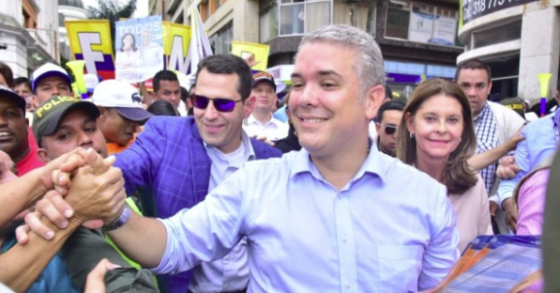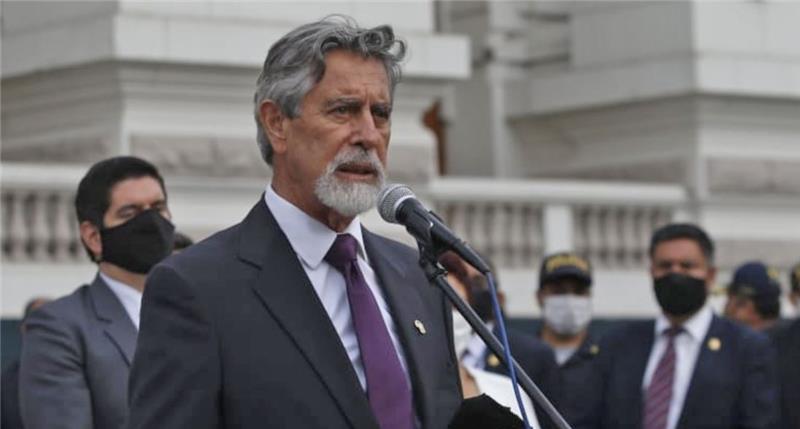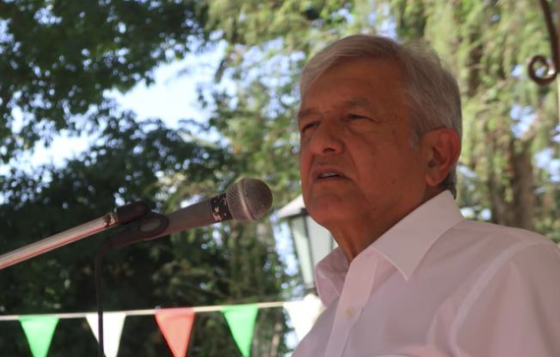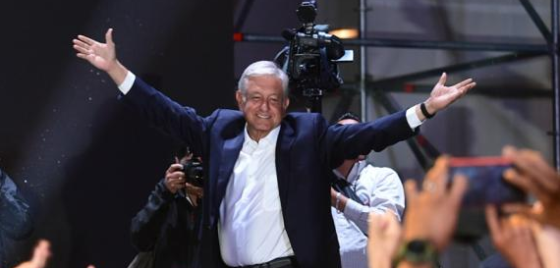
Will Colombia’s New President Deliver on His Promises?
Iván Duque, a conservative former senator, on Sunday won Colombia’s presidential runoff election. What does it mean for the country?
A Daily Publication of The Dialogue
Peru’s Congress on Monday selected centrist lawmaker Francisco Sagasti as Peru’s new interim president—the country’s third in a week. Legislators selected Sagasti, an engineer from the centrist Purple Party, following Sunday’s resignation of interim President Manuel Merino, who stepped down amid violent protests after just five days in office. Merino had replaced President Martín Vizcarra, whom Congress removed from office on Nov. 9. Legislators had declared Vizcarra “morally unfit” for office over his handling of the Covid-19 pandemic and allegations of corruption, which he has denied. Newspapers and analysts have called Vizcarra’s ouster a “coup,” and the protests it sparked left at least two dead and were the largest in Peru in two decades. What is at the root of Peru’s political instability, and to what extent are protests likely to continue and intensify? What will the next five months hold for Peru ahead of the scheduled April 2021 elections? What implications will the crisis have for the country’s already hard-hit economy and investment climate?
Cynthia McClintock, professor of political science and international affairs at The George Washington University: “The root cause of the impeachment was elites’ pushback against Vizcarra’s anti-corruption reforms. Vizcarra championed the prosecution of under-the-table payments by companies to politicians—a practice, entrenched for centuries, that had catalyzed the prosecution of all four presidents elected since 2001 and scores of additional authorities. Many legislators feared an end to their own immunity from prosecution. Other legislators have personal stakes in for-profit universities, which are threatened by new, higher standards. Another cause of the impeachment was legislators’ political ambitions. One political party was seeking amnesty for its imprisoned leader. Others hoped to tilt the 2021 electoral playing field in their favor. Many wanted to overturn the new prohibition against legislators’ re-election. An additional cause was that, given the brevity of this legislative term (January 2020-July 2021), some strong candidates chose not to run in 2020, and many legislators are rookies. They reacted intemperately to criticism by Vizcarra. They wrongly assumed that allegations of corruption against Vizcarra would significantly decrease his support; his approval remains above 50 percent. When what matters to Peruvians is that Vizcarra was weakening the ‘traditional corrupt political class,’ Merino was bringing it back. Worse yet, Merino enabled repression against largely peaceful protesters who hailed from all social classes and all regions. Soon, the Constitutional Tribunal is to rule on the ‘permanent moral incapacity’ clause and might catalyze the restoration of Vizcarra. (This clause is vague, but it is the same clause that enabled the impeachment of Alberto Fujimori and the impeachment threat against Pedro Pablo Kuczynski.) More likely, legislators will elevate a more respected member of their ranks. Meanwhile, the instability is worsening Peru’s economic crisis and investment climate and turning attention away from the pandemic, which has hit Peru exceptionally hard. The country is both fighting and crying.”
Julio Carrión, associate chair of the Department of Political Science and International Relations at the University of Delaware: “Peru’s crisis of governability has three causes. The first concerns the flaws in constitutional design. The unicameral system created by the 1993 Constitution encourages rushed decisions that cannot be checked by a second chamber. Unicameralism gives unrestrained power to congressional majorities, which is problematic when checks and balances are fragile, as in Peru. This is compounded when political parties, in the proper sense of term, do not exist—which is the second cause. With very few exceptions, the parties that control most seats in the legislature are nothing more than the extension of business or particularistic interests. A few are family fronts for for-profit universities; one party is the expression of a messianic, syncretic cult whose commitment to democracy is questionable. Another party is allied to a military officer, who is in prison for killing members of the police during his attempted coup against democracy in 2005. The third cause is the ambiguity of an old constitutional norm that allows Congress to remove the president if s/he is found to be ‘morally unfit.’ Before 1993, this article was rarely invoked. With the unicameral system, and an aggressive majority, it has been used four times in the last three years. The institutional dysfunction which led to former President Vizcarra lacking a vice president—when the Constitution requires two—has temporarily turned Peru into a parliamentary regime. Any representative who can muster a congressional majority will become Peru’s next president. All of this speaks poorly to Peru’s prospects. The protests in the street have also become a significant factor, and they will be influential in what will happen next. Indeed, it will be the protesters who issue the ultimate vote, accepting or rejecting, the president appointed by Congress. Meanwhile, managing the economy and fighting the pandemic have been put on hold.”
César Gutiérrez, director of utilitiesperu.com in Lima: “The current crisis is a combination of events that the country has experienced in the last 30 years, mainly acts of corruption by the political class that have been denounced, prosecuted and have occupied the media with which the millennial generation has grown up. To a lesser extent, the unresolved exclusions of the reforms of the 1990s have also been influential. Outrage has increased over the last four years, with Congress carrying the stigma of subordinate interest, privilege and the low qualifications of members of Congress. Last week’s vacancy’s legality has been biasedly questioned, a doubt that has been installed in the collective mind by a persistent campaign by the media. Private investment has been elusive in the past four years, and it is natural for investment to stall amid an electoral period such as the one Peru is undergoing. To this has been added the crisis, which still has no way out. No decisions will be made until this transition period has passed and there is a new government whose stability is guaranteed and whose positions are known, which is expected to come in the third quarter of next year. The international perception of Peru and its economic management has not yet deteriorated. The EMBIG has not exceeded 144 basis points, a fairly good figure. However, if the uncertainty continues, not only will this index grow, but there will also be a declassification of the country risk for global and sovereign bonds.”
Kelli Bissett-Tom, director for Americas Sovereign Ratings at Fitch Ratings: “The interim president will face legitimacy challenges lacking a popular mandate until the new president and Congress are inaugurated on July 28, 2021. Governability challenges are likely to persist from congressional fragmentation, particularly if the next president lacks party representation in Congress. Many of the issues that contributed to Peru’s several political crises since 2016 remain unresolved and could reignite tensions between the president and legislature. Political and institutional reforms strongly supported by a popular referendum have only been partially enacted. Several constitutional tribunal judges have overextended their terms amid discord on how to replace them. Government checks and balances have been stretched. Peru will experience one of the steepest economic contractions in Latin America and rating peers, near 12.5 percent in 2020, exacerbated by Peru’s stringent early lockdown but also a weak social insurance system amid high business informality. The current political crisis will curb private nonmining investment at least through the presidential and congressional elections on April 11, 2021, dampening economic expectations for 2021 below what was otherwise expected to be a relatively speedy recovery, near 8 percent-9 percent growth, according to the central bank’s macro expectations survey. Some congressional initiatives, such as pension withdrawals, will temporarily support household consumption but accelerate comprehensive discussions about Peru’s pension system. Other initiatives pose more risk to infrastructure investors or the financial system. Greater capacity for political dialogue will be required for the next administration and Congress to tackle core economic challenges and to chart a reliable course of fiscal consolidation.”
[Editor's Note: When Sagasti was a candidate for a seat in Congress last year, he told the Advisor that the "main contribution" of members of Congress "is to behave decently and begin the process of restoring public trust in politics." Read the full Q&A here.]
 The Latin America Advisor features Q&A from leaders in politics, economics, and finance every business day. It is available to members of the Dialogue’s Corporate Program and others by subscription.
The Latin America Advisor features Q&A from leaders in politics, economics, and finance every business day. It is available to members of the Dialogue’s Corporate Program and others by subscription.
Iván Duque, a conservative former senator, on Sunday won Colombia’s presidential runoff election. What does it mean for the country?
Mexicans go to the polls on Sunday, July 1, for the country’s presidential, legislative and local elections. What can we expect?
Leftist Andrés Manuel López Obrador swept to victory Sunday in Mexico. What changes are in store?
 Sagasti
Sagasti

